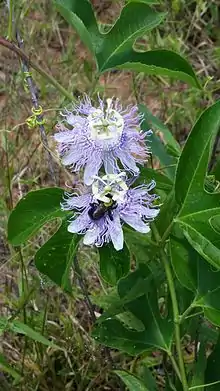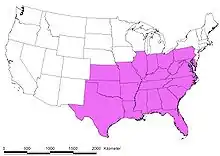Passiflora incarnata
Passiflora incarnata, commonly known as maypop, purple passionflower, true passionflower, wild apricot, and wild passion vine, is a fast-growing perennial vine with climbing or trailing stems. A member of the passionflower genus Passiflora, the maypop has large, intricate flowers with prominent styles and stamens. One of the hardiest species of passionflower, it is both found as a wildflower in the southern United States and in cultivation for its fruit and striking bluish purple blooms.
| Passiflora incarnata | |
|---|---|
 | |
| Flower | |
 | |
| Fruit | |
| Scientific classification | |
| Kingdom: | Plantae |
| Clade: | Tracheophytes |
| Clade: | Angiosperms |
| Clade: | Eudicots |
| Clade: | Rosids |
| Order: | Malpighiales |
| Family: | Passifloraceae |
| Genus: | Passiflora |
| Species: | P. incarnata |
| Binomial name | |
| Passiflora incarnata L., 1753 | |
 | |
Description
The stems can be smooth or pubescent; they are long and trailing, possessing many tendrils. Leaves are alternate and palmately 3-lobed and occasionally 5-lobed, measuring 6–15 centimetres (2.4–5.9 in). They have two characteristic glands at the base of the blade on the petiole. Flowers have five bluish-white petals. They exhibit a white and purple corona, a structure of fine appendages between the petals and stamens. The large flower is typically arranged in a ring above the petals and sepals. They are pollinated by insects such as bumblebees and carpenter bees, and are self-sterile. The flower normally begins to bloom in July.[1]
The fleshy fruit, also referred to as a maypop, is an oval yellowish berry about the size of a hen egg; it is green at first, but then becomes yellow as it matures. As with other passifloras, it is the larval food of a number of lepidoptera species, including the zebra longwing, the Gulf fritillary, the crimson-patched longwing, the Julia, the Plebeian sphinx, and the variegated fritillary.[2] In many cases its fruit is very popular with wildlife. The egg-shaped green fruits 'may pop' when stepped on. This phenomenon gives the P. incarnata its common name, as well as the fact that its roots can remain dormant for most of the winter underground and then the rest of the plant "pops" out of the ground by May, unharmed by the snow.
The maypop occurs in thickets, disturbed areas, near riverbanks, and near unmowed pastures, roadsides, and railroads. It thrives in areas with plentiful sunlight. It is not found in shady areas beneath a forest canopy.
The Cherokee in the Tennessee area called it ocoee; the Ocoee River and valley are named after this plant, which is the Tennessee state wildflower.[3] For thousands of years the maypop was a staple food and medicinal plant for the Cherokee and to this day it is a revered piece of their heritage. This, and other passionflowers are the exclusive larval host plants for the Gulf fritillary and non-exclusive for the variegated fritillary butterflies.[4]
Cultivation
Passiflora incarnata is easily cultivated and in its native range and homeland is a common low maintenance garden plant that can be trained to adorn fences and arbors. The wild maypop is an aggressive vine native to the southeastern United States extending into the central US reaching Illinois, Indiana, and Ohio.[5] The vines can carpet the floor of thickets within days in favorable weather. The plants grow in full sun and need direct sunlight for at least half of the day. The best soils for P. incarnata are well-drained [6] but the plants tolerate occasionally wet and acidic soils. The plants have a high drought tolerance. P. incarnata can be planted all the year in zone 7–11 (hardiness zone). The space between two plants is 36–60 inches (91.44 – 152.4 cm).[5] One to two years are necessary before they begin bearing. Each flower has a very short life (about one day). Then the fruit develops in two to three months.[6] The harvest depends on vine size and age of the plant but one reported 10–20 fruits per vine. Seeds can be collected in the fall after the fruit has begun to shrivel. There are some problems with nematodes and caterpillars in the culture of P. incarnata.[5]
The flowers appear suitable for bumblebee pollination and may attract ruby-throated hummingbirds. As both bees and hummingbirds look for nectar, the pollen filled flower anthers brush the back of the bee or the face of the hummingbird, enabling pollen to be readily transferred to the central sticky stigma.
Passiflora incarnata can potentially become an agricultural weed. The genus Passiflora introduced for agricultural purpose has been reported as an important weed in certain regions of the world.[7] The United States Department of Agriculture notes that P. incarnata is referred to as a weed by these publications:[8] Weeds of Kentucky and adjacent states: a field guide[9] and Weeds of the United States and Canada.[10]
Mechanical control as removing the suckers regularly is advised to prevent the spreading of maypop. It is also recommended to train the vines onto trellis and fences to limit propagation.[7]
Traditional medicine
Historical uses and folk medicine
Historically, the plant has been used as a herbal medicine in the belief it may treat anxiety, insomnia, or hypertension,.[11] In traditional medicine, passionflower is reputed to have sedative effects as used historically in Europe,.[12][13]
Passionflower is included in pharmacopeias, such as the European and British Pharmacopoeias in which the dried aerial parts of the plant are mentioned.[12] In North America and South America, tea made from the roots is used as a tonic.[12] The U.S. Food and Drug Administration (FDA) had formally approved the herb as an over-the-counter sedative, however in 1978, the agency withdrew this approval during a drug-class review because manufacturers did not submit any evidence regarding its safety and effectiveness.[14]
Safety
A 2013 literature review found that the herb has "a good safety profile," and the plant "has shown a wide spectrum of pharmacological activities in preclinical experiments, including anxiolytic, sedative, antitussive, antiasthmatic, and antidiabetic activities." However, the clinical research on possible effects of the plant is limited by poor methodologies and inconsistent definitions, as well as a lack of details regarding the extract ratios used.[12] One study found that a daily intake of 800 mg of a dried alcoholic extract, taken over the course of 8 weeks for anxiety, appeared to have been safe.[12]
When used in food manufacturing as a flavor, passionflower is generally recognized as a safe substance (GRAS).[15]
Passionflower possibly "can be used for the relief of mild symptoms of mental stress and to aid sleep."[13] There is no evidence that P. incarnata has anti-disease activity.[12][13][16]
Interactions
Possible interactions with following medications:[13][17]
- Sedatives
- Anticoagulants
- Monoamine oxidase inhibitors
P. incarnata may increase main effects or side effects of medications listed above.[17]
For oral consumption, pregnant or breastfeeding women should use caution and seek medical advice before orally consuming P. incarnata. The effects of oral ingestion of the plant compounds on reproduction or on unborn child have not been tested. The oral consumption of this plant may impair the ability to drive and use machinery.[13][15]
Phytochemistry
P. incarnata contains flavonoids and alkaloids,[13][16][17] with leaves containing the greatest concentration of flavonoids. Other flavonoids present in P. incarnata include chrysin, apigenin, luteolin, quercetin, kaempferol, and isovitexin.[18] Alkaloids include the fluorescent indole alkaloid harmaline, which selectively and reversibly inhibits the MAO-A enzyme.a
Culinary uses
The fruit of passionflower may be used for jams, jellies and desserts. The juice is a favourite flavouring in drinks. It can be used as a fresh substitute for its commercially grown South American relative, Passiflora edulis, a related species with similar sized fruit. The fruit can be eaten by hand, as indicated by its common name, given to it by Cajuns: liane de grenade or "pomegranate vine". It has a slightly sweet-tart taste and a pleasant scent when fully ripe.
Notes
- 1.^a See Monoamine oxidase inhibitor on Wikipedia.
References
- "Maypop-Passion Flower – Passiflora incarnata". Root Buyer. Retrieved 18 October 2018.
- The Xerces Society (2016), Gardening for Butterflies: How You Can Attract and Protect Beautiful, Beneficial Insects, Timber Press.
- "State Symbols". Tennessee Government. Archived from the original on May 30, 2013. Retrieved October 24, 2011.
- Horn, compiled and edited by Dennis Horn and Tavia Cathcart ; technical editor: Thomas E. Hemmerly ; photo editors: David Duhl and Dennis (2005). Wildflowers of Tennessee, the Ohio Valley, and the Southern Appalachians : the official field guide of the Tennessee Native Plant Society. [Edmonton]: Lone Pine Pub. p. 105. ISBN 978-1-55105-428-5.
- Gilman EF (2015). "Passiflora incarnata (Wild Passion Flower, Maypop)". Institute of Food and Agricultural Sciences, University of Florida. Retrieved 23 January 2018.
- "Purple passionflower" (PDF). US Department of Agriculture. 15 August 2008.
- Mc Guire, C. M. (1999). "Passiflora incarnata (Passifloraceae): A new fruit crop". Economic Botany. 53 (2): 161–176. doi:10.1007/bf02866495. S2CID 24177586.
- PLANTS Database. "Purple Passionflower". United States Department of Agriculture. Retrieved 22 November 2015.
- Haragan, P. D. (1991). Weeds of Kentucky and Adjacent States: A Field Guide. Lexington, KY: The University Press of Kentucky. ISBN 978-0-8131-3369-0.
- Southern Weed Science Society (1998). Southern Weed Science Society's weeds of the United States and Canada [electronic resource]. Champaign, Ill: Southern Weed Science Society.
- "Passiflora incarnata". Plants For A Future. 2020.
- Miroddi M, Calapai G, Navarra M, Minciullo PL, Gangemi S (2013). "Passiflora incarnata L.: Ethnopharmacology, clinical application, safety and evaluation of clinical trials". Journal of Ethnopharmacology. 150 (3): 791–804. doi:10.1016/j.jep.2013.09.047. PMID 24140586.CS1 maint: uses authors parameter (link)
- "Passiflora". European Medicines Agency. Retrieved 22 November 2015.
- https://www.webmd.com/vitamins/ai/ingredientmono-871/passionflower
- "Food Additive Status List". US Food and Drug Administration. 4 January 2018. Retrieved 23 January 2018.
- Miroddi, M.; Calapai, G.; Navarra, M.; Minciullo, P.L.; Gangemi, S. (2013). "Passiflora incarnata L.: Ethnopharmacology, clinical application, safety and evaluation of clinical trials". Journal of Ethnopharmacology. 150 (3): 791–804. doi:10.1016/j.jep.2013.09.047. ISSN 0378-8741. PMID 24140586.
- Ehrlich, Steven D. "Passionflower". University of Maryland. A.D.A.M. Retrieved 22 November 2015.
- Dhawan K., Dhawan S., Sharma A. (2004). "Passiflora: a review update". Journal of Ethnopharmacology. 94 (1): 1–23. doi:10.1016/j.jep.2004.02.023. PMID 15261959.CS1 maint: multiple names: authors list (link)
External links
| Wikimedia Commons has media related to Passiflora incarnata. |